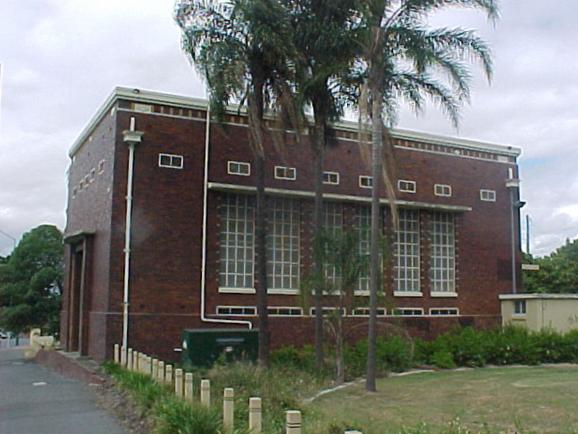Addresses
Type of place
Substation
Period
Postwar 1945-1960
Style
Stripped Classical
Addresses
Type of place
Substation
Period
Postwar 1945-1960
Style
Stripped Classical
This tramway substation was constructed circa 1948 during the postwar expansion of Brisbane’s public transport infrastructure. Electric trams were first introduced to Brisbane in 1897 and a number of substations were constructed throughout the City in the first half of the twentieth century in order to support continued expansion of the tramway system. This substation was designed by City Architect Frank Costello, who also designed a number of other municipal buildings in Brisbane throughout his career. In 1969 electric trams were phased out and the substation, still owned by SEQEB, was used as a museum for many years.
Lot plan
Key dates
Local Heritage Place Since —
Date of Citation —
Construction
Walls: Face brickPeople/associations
Frank Costello (Architect)Criterion for listing
(A) Historical; (E) Aesthetic; (H) Historical associationInteractive mapping
Lot plan
Key dates
Local Heritage Place Since —
Date of Citation —
Construction
Walls: Face brickPeople/associations
Frank Costello (Architect)Criterion for listing
(A) Historical; (E) Aesthetic; (H) Historical associationInteractive mapping
History
The first electric tramway began operating in Brisbane on 21 June 1897 and by 1914 tracks had been laid to Windsor. At the end of the First World War, it was clear the tramway system had become a necessity for mass transport. The system was expanded during the late 1920s and 30s by the newly formed greater Brisbane City Council. To cope with this expansion a substation had been erected in c.1927 at Windsor. However with further expansion of public transport in the post WWII period its capacity would prove inadequate.
In June 1947 the Brisbane City Council, utilising the State Transport Facilities Act 1946, resumed a number of private bus services in an attempt to co-ordinate bus routes. The previous war years had proved the most profitable for the Council transport system. the Brisbane City Council In 1947-48 placed orders for thirty electric trolley bus chassis. As these were to arrive during the 1949-50 period it was necessary to have in place larger substations which would cope with the increased electricity demands of the trolley buses. This expansion included the purchase of both diesel and electric powered buses.
This tramway Substation was erected in c.1948 as part of this post war expansion of Brisbane City transport infrastructure. While approval to construct the substation had been given in 1945 construction had been delayed until a suitable site had been located. The substation was to be erected at an estimated cost of £5000/0/0 and work on the structure was to be under taken by staff of the Electricity Department.
The structure was designed by Frank Costello who served as City Architect 1941-1952 and City Planner 1946-1952 before falling foul of the newly elected Roberts administration in 1952 which resulted in his and a number of other administrative staff’s dismissal. Costello was involved in other numerous designs of municipal buildings which included a number of substations, Mt Coot-tha Look out, Eagle farm sewerage pumping station, air raid shelters, Mt Crosby Filtration Plant and a number of planning schemes which have been described as ‘lost potential’ as few were put into practice.
Costello’s contribution to Municipal architecture was impressive. He is credited with providing an ‘architectural legacy to the city of Brisbane (which) was the architectural style new to Brisbane City Council.’ His work is reputed to be heavily influenced by the work of Netherlander Willem Dudok. The Windsor substation has been described as one of the best examples of Costello’s work.
In 1969, Brisbane’s electric trams were phased out and replaced completely by motorised buses. In October 1986, the then administering body for electricity SEQEB, utilised the building as a museum. The property has continued to be controlled by the administrative electrical body, now called ENERGEX and the building has ceased to operate as a museum pending relocation.
Statement of significance
Relevant assessment criteria
This is a place of local heritage significance and meets one or more of the local heritage criteria under the Heritage planning scheme policy of the Brisbane City Plan 2014. It is significant because:
References
-
Brisbane City Council. Detail Plan No: 565. Dated 28.11.1935
-
Chaseling, Scott, Frank Costello: City Architect 1941-1952, City Planner 1946-1952. B. Arch. Thesis, University of Queensland, 1997
-
G. Greenwood and J. Laverty. Brisbane 1859-1959: A History of Local Government. Brisbane: BCC, 1959.
-
Osford-Jordan, Christopher William. Study of the Architectural History of Brisbane Electricity Substations Before 1953. (Unpub Thesis University of Queensland) January 1984
-
Reports and Proceedings of the Brisbane City Council For the years; July 1946-June 1947; July 1947-June 1948; July 1948-June 1949
-
Watson, Donald and Judith McKay. A Directory of Queensland Architects to 1940. (St. Lucia: U of Q Press, 1984)
-
Laverty, John. ‘John Beals Chandler: The little man at City Hall’. Brisbane: Corridors of Power. Brisbane History Group. Papers No.15 - 1997
Citation prepared by — Brisbane City Council (page revised June 2022)

